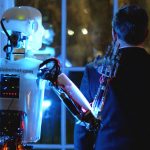 By John W. Kennedy, Ph.D., CEO, NJMEP
By John W. Kennedy, Ph.D., CEO, NJMEP
While manufacturing is not often viewed as a viable career sector, it remains a technical engine for the US economy, with evolution further advancing the need for skilled workers. It’s simple: there are more people in the world who need more things, and someone has to make them—which may require working alongside robots.
A common concern is that advanced robotics poses a threat to skilled labor jobs. On the contrary, automation and robotics are creating “additive” careers that are considered hybrids. Robotic technology is poised to be a growing field that creates new jobs and evolves current roles.
Hybrid jobs are the future
Robots don’t eliminate the need for skilled laborers because human involvement is needed to accomplish robotic tasks. Collaborative robotics in particular has provided more people within the manufacturing environment to become champions of the automation within their processes. For example, Computerized Numeric Controls (CNC) operators and programmers can use their knowledge and experience to efficiently program robots through processes.
Other positions that can prosper as robotics strengthens the manufacturing industry include:
- Machinist with CNC programming experience
- Robotics technicians
- Quality technicians
- Industrial engineers
- CAD-CAM designers
- Mecha-tronics experts
Change spurred by innovation is nothing new. The workforce has adapted to the need for more computer knowledge, and continued introduction of robots will change the workforce as it has done for centuries. Now, laborers must find the best direction to maintain relevancy in the workplace.
Adapt or fall behind
As technology advances, the real competition will continue to remain between workers, not their coexisting machines. Look at tool and die makers in an evolutionary context. These individuals generally began their work from design drawings developed by engineers. They would then lay out the design on the raw material, cut it to size and shape using manually or controlled machine and hand tools.
However, since the advent of computing in the manufacturing fields (including CNC, CAD-CAM and other Computer-Aided Technologies), tool and die makers have increasingly added a myriad of IT skills to their daily workload. Today’s tool and die makers are generally required to have all of the traditional skills, plus substantial digital skills. These formidable requirements make the field challenging to master.
All positions in a manufacturing facility have changed and will change again due to technology, including: sales and marketing, accounting, human resources, engineering, design, production, assembly, inventory, and logistics.
As jobs change, manufacturing professionals must be prepared and develop ways to make new and old tools benefit each job role. Embracing hybrid education through collegiate, technical and industrial trainings will keep workers on track though they may be in uncharted territory. Openness to change will keep manufacturing jobs relevant.
About the Author
John W. Kennedy, Ph.D. is CEO of New Jersey Manufacturing Extension Program (NJMEP). He previously served as the organization’s COO and has more than two decades of experience in the manufacturing and engineering arenas.